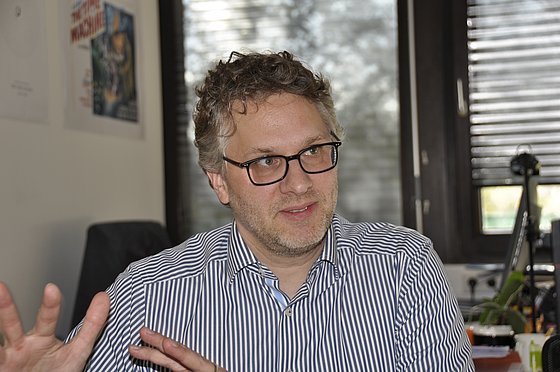
Dr Dominik Orth /
Modern German Literature / Department of German Studies
Photo: UniService Transfer
Mauerschau - The GDR as a film
Dr Dominik Orth and the films about a vanished state
9 November marks the 30th anniversary of the fall of the Berlin Wall and thus the beginning of the end of the German Democratic Republic. A once-in-a-century event that has been the subject of a wide range of academic disciplines ever since. Wuppertal literature and media scholar Dr Dominik Orth, in collaboration with Prof. Dr Heinz-Peter Preußer from Bielefeld University, is publishing the book "Mauerschau - Die DDR als Film" in spring 2020.
The beginnings of this book date back ten years. Back then, the two academics and another colleague organised activities in the form of a film series, a conference and a publication as part of the 20th anniversary commemoration of the fall of the Berlin Wall. "The focus was on the period after reunification. At the time, we deliberately drew on both literary and film narratives that focused in particular on the period after reunification," explains Orth, "and now that the 30th anniversary was approaching, we thought we could build on these preparations and then included the GDR itself as a subject in films as well as films from the GDR." The decisive novelty of this book is the broad overview. "There are many publications on individual films, on individual phenomena," he explains, "but few overviews that deal with films from the GDR as well as films about the GDR from the time when the state still existed." This gave rise to the idea of publishing a book in which all the facets of self-images and images of others from the period of the GDR's existence as well as the post-GDR period flow into one another.
A lecture series to kick things off
To tackle this mammoth task, the two editors enlisted the help of other academics and organised a large lecture series at Bielefeld University in the summer of 2018. They approached colleagues from a wide range of disciplines with a selection of particularly relevant films. "We then approached interdisciplinary Germanists, film scholars, media scholars and historians who had already appeared as GDR experts and therefore had experience, as well as experts who had worked on GDR films or films that were subsequently made about the GDR. We also asked academics who have always scrutinised the relationship between contemporary history and narrative from a cultural studies perspective." The lectures of the lecture series on selected films in and about the GDR are included as essays in the new anthology.
DEFA - Deutsche Film AG
But how do you recognise a GDR film? "By the DEFA logo," laughs Orth, "that would be the simple answer. DEFA was the state monopoly company that was responsible for all film production in the GDR. DEFA was controlled by the state, the party, so of course the films have to be categorised when you watch them." But it's not quite that simple, because the variety of productions - DEFA produced around 700 feature films, 750 animated films and 2,250 documentaries and short films in its time - was astonishingly large. "There are propaganda films, of course, but also very sophisticated films that are aesthetically very exciting from today's perspective. There are genre films, fairy tale films, some of which are ideologically influenced," the humanities scholar lists, "there are also science fiction and agent films. Even critical films that were produced in the GDR. That's a huge variety." Sometimes, it seems today, the filmmakers got in their own way, as there was often politicisation in places that didn't need it. Orth says: "A good example is `Berlin, Ecke Schönhauser...' from 1957. That's a kind of streetwise film. It's about young people who existed in exactly the same way in the West. And in 'Berlin, Ecke Schönhauser...' they politicised it, which wouldn't have been necessary. Basically, like in 'They don't know what they're doing' (USA, 1955 with James Dean), it's about the problems of young people, regardless of where they live. And in this case, a political dimension has simply been added, a tendency that can be seen in many films."

Dr Dominik Orth /
Modern German Literature / Department of German Studies
Photo: UniService Transfer
There was no censorship
"Officially, there was no censorship," says Orth firmly and then has to grin, because "the films had to be approved by the state. In other words, there were various institutions that made sure that the film was in line with the party line from the first film idea to the end." Given this requirement, it is surprising that only 30 films were banned, their production cancelled or not shown at all, given the diversity of DEFA productions. Orth has an explanation for this: "Many films were already influenced in the production process, which was interwoven with the party from the outset. There is this saying about the scissors in the head. The filmmakers knew in advance what could cause problems and cut out the relevant scenes straight away or didn't shoot them at all. They censored themselves, if you like, before the special and de facto censorship came about." In this context, Orth also mentions the so-called "Kahlschlag Plenum" from 1965, when the artists of the GDR were accused at the 11th Plenum of the Central Committee of the SED. Spokesman Erich Honecker accused them of nihilism and pornography, among other things. Numerous films - including those by regime-friendly directors - were banned as a result, along with many books.
Die Spur der Steine, a basement film
Perhaps the best-known banned, so-called basement film - index films were only stored in the basement archive - is 'Die Spur der Steine', a DEFA production starring Manfred Krug from 1966. "Party functionaries are portrayed in the film," explains Orth, "and the portrayal of these party functionaries did not match the party's self-image. In the film, they were quite stubborn, pig-headed party soldiers. One of them committed adultery and didn't recognise the resulting child. That was morally highly reprehensible! And the party was portrayed as divided with different wings. Of course, that didn't suit the SED. At the same time, there is such a cowboy mentality, it's about a workers' brigade. Some of them are staged like in a western, and their behaviour is correspondingly anarchistic. They jump naked into a pond and throw a policeman into the water with them. That didn't sit well with the state leadership." The director's intention, which was to highlight problems that would contribute to an improvement in conditions, was seen as a threat by the state leadership, who made sure that the film disappeared from cinemas after a few days. "The party even organised troublemakers who interrupted the screening with heckling or even caused the film to be stopped," explains Orth. In fact, 'The Trail of Stones' was only shown again after the fall of the Wall.
Outstanding contemporary history
The expatriation of Wolf Biermann in 1976 and the associated departure of well-known DEFA artists such as Manfred Krug, Armin Müller-Stahl and Angelika Domröse briefly led to more freedom in film, so that the 1980 production "Solo Sunny", about the self-discovery of a young artist, was even allowed to deal with the taboo subject of suicide. "It's actually amazing that the film could be released," says Orth, because "the party leadership didn't like this film because it suggested that people from socialist society had the same problems as those from Western society."
In terms of contemporary history, the DEFA feature film productions also made other outstanding films. "The Murderers Are Among Us" (1946) was the first DEFA film to be produced before the founding of the state. It is a direct confrontation with the Nazi regime. Aesthetically well made, it has many references to expressionist film. Der geteilte Himmel' (1964) by Konrad Wolf is a literary film adaptation of an original by Christa Wolf. On the one hand, the film implicitly legitimises the division and the Wall, but is aesthetically and artistically highly interesting," says Orth. "The Legend of Paul and Paula (1973) is basically a love film and is considered a cult film today. Jacob the Liar' (1974) is the only DEFA literary film adaptation to be nominated for an Oscar. These are truly remarkable works of contemporary history."

Dr Dominik Orth /
Modern German Literature / Department of German Studies
Photo: UniService Transfer
Confronting the past with Ostalgie
And then there's the time after reunification. How do filmmakers portray the GDR after the fall of the Wall? "There are different focuses," explains Orth, "firstly as a nostalgic place, i.e. films like 'Sonnenallee' (1999) or 'Good Bye, Lenin!' (2003), which thematise life in the GDR, especially the lives of young people growing up. The political aspect doesn't play such a big role here. The other is the state of injustice and espionage. The Lives of Others' (2006) is a good example, where the elements to be criticised that went hand in hand with the GDR were also addressed. But there are also exceptional productions such as 'Wir können auch anders' (1993) by Detlev Buck, which is the GDR as the Wild East. A road movie through the GDR."
The filmmakers approach the subject of the GDR in classic patterns. Both through comedies, which deal with the whole thing humorously, and through tragedies. In some cases, the film view also transfigures the actual history. "Of course, these films also have a social function. It's a form of remembrance," explains the academic, "of course they weren't originally produced for remembrance, but as mass media products they contribute to a cultural memory. And memory always transfigures. What's more, we're talking about feature films that have references to reality, but cannot be equated with reality because they fictionalise. This is also an important approach in our book. The authors take the approach that these are only images of the GDR and not the GDR as it really was."
30 years later, a new generation has emerged that only knows the GDR from history books, films and stories. "In the meantime," summarises Orth, "and you can see this in the series 'Deutschland 83', which was produced in 2015 and also has the GDR as its theme, the GDR is now just a backdrop for the 1980s. The series is more of an 80s series than a series about the GDR. The GDR still existed back then. But here it is more of a feature for an espionage plot. The GDR is simply part of it when you make something about the 80s. There is at most a rudimentary critical examination."
The book "Mauerschau - Die DDR als Film. Contributions to the Historicisation of a Vanished State", edited by Dominik Orth and Heinz-Peter Preußer, will be published by De Gruyter in spring 2020.
Uwe Blass (interview from 29.10.2019)
Dominik Orth completed a master's degree in cultural studies, German studies and history at the universities of Bonn and Bremen. He completed his doctorate at the University of Bremen in 2012. Since 2017, he has been working as a lecturer for special tasks in the field of Modern German Literature in the Department of German Studies at the University of Wuppertal.

Dr Dominik Orth
Modern German Literature / Department of German Studies
Photo: UniService Transfer
Outstanding in contemporary history
The expatriation of Wolf Biermann in 1976 and the associated departure of well-known DEFA artists such as Manfred Krug, Armin Müller-Stahl and Angelika Domröse briefly led to more freedom in film, so that the 1980 production "Solo Sunny", about the self-discovery of a young artist, was even allowed to deal with the taboo subject of suicide. "It's actually amazing that the film could be released," says Orth, because "the party leadership didn't like this film because it suggested that people from socialist society had the same problems as those from Western society."
In terms of contemporary history, the DEFA feature film productions also made other outstanding films. "The Murderers Are Among Us" (1946) was the first DEFA film to be produced before the founding of the state. It is a direct confrontation with the Nazi regime. Aesthetically well made, it has many references to expressionist film. Der geteilte Himmel' (1964) by Konrad Wolf is a literary film adaptation of an original by Christa Wolf. On the one hand, the film implicitly legitimises the division and the Wall, but is aesthetically and artistically highly interesting," says Orth. "The Legend of Paul and Paula (1973) is basically a love film and is considered a cult film today. Jacob the Liar' (1974) is the only DEFA literary film adaptation to be nominated for an Oscar. These are truly remarkable works of contemporary history."
Confronting the past with Ostalgie
And then there is the period after reunification. How do filmmakers portray the GDR after the fall of the Wall? "There are various focal points," explains Orth, "firstly as a nostalgic place, i.e. films such as 'Sonnenallee' (1999) or 'Good Bye, Lenin!' (2003), which thematise life in the GDR, especially the lives of young people growing up. The political aspect doesn't play such a big role here. The other is the state of injustice and espionage. The Lives of Others' (2006) is a good example, where the elements to be criticised that went hand in hand with the GDR were also addressed. But there are also exceptional productions such as 'Wir können auch anders' (1993) by Detlev Buck, which is the GDR as the Wild East. A road movie through the GDR."
The filmmakers approach the subject of the GDR in classic patterns. Both through comedies, which deal with the whole thing humorously, and through tragedies. In some cases, the film view also transfigures the actual history. "Of course, these films also have a social function. It's a form of remembrance," explains the academic, "of course they weren't originally produced for remembrance, but as mass media products they contribute to a cultural memory. And memory always transfigures. What's more, we're talking about feature films that have references to reality, but cannot be equated with reality because they fictionalise. This is also an important approach in our book. The authors take the approach that these are only images of the GDR and not the GDR as it really was."
30 years later, a new generation has emerged that only knows the GDR from history books, films and stories. "In the meantime," summarises Orth, "and you can see this in the series 'Deutschland 83', which was produced in 2015 and also has the GDR as its theme, the GDR is now just a backdrop for the 1980s. The series is more of an 80s series than a series about the GDR. The GDR still existed back then. But here it is more of a feature for an espionage plot. The GDR is simply part of it when you make something about the 80s. There is at most a rudimentary critical examination."
The book "Mauerschau - Die DDR als Film. Contributions to the Historicisation of a Vanished State", edited by Dominik Orth and Heinz-Peter Preußer, will be published by De Gruyter in spring 2020.
Uwe Blass (interview from 29.10.2019)
Dominik Orth completed a master's degree in cultural studies, German studies and history at the universities of Bonn and Bremen. He completed his doctorate at the University of Bremen in 2012. Since 2017, he has been working as a lecturer for special tasks in the field of Modern German Literature in the Department of German Studies at the University of Wuppertal.
